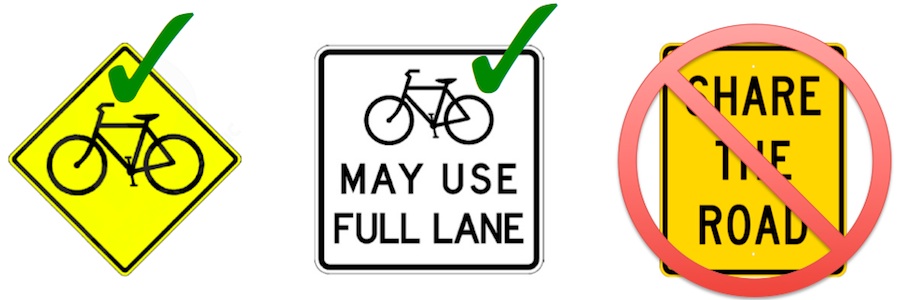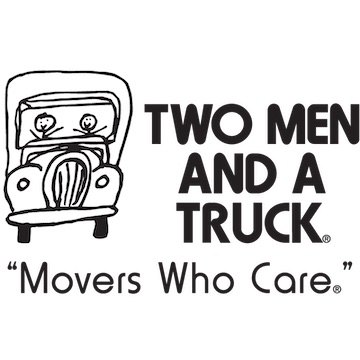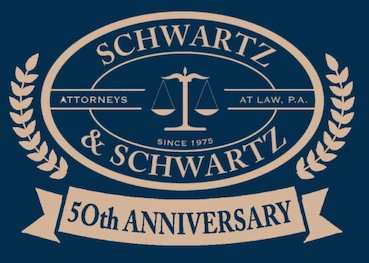Why “Share The Road” Is Gone in Delaware
Published in the Institute of Transportation Engineers Bicycle and Pedestrian Council Newsletter
April 4, 2014

“Share The Road”: It’s practically the national motto of cycling advocacy in the United States.
It’s the cycling “message” on license plates in Colorado, Florida, Georgia, Illinois, Indiana, Iowa, Kentucky, Louisiana, Maryland, Mississippi, North Carolina, South Carolina, Ohio, Oregon, Texas, Utah, Washington, and Wisconsin.
But not in Delaware. In fact, as of last November, just the opposite.
In November, the Delaware Department of Transportation announced that, effective immediately, Delaware would stop using the MUTCD-approved “Share The Road” plaque (W16-1P). More, the department would also start removing all “Share The Road” signs currently installed in Delaware.
How did the state’s cycling advocacy group Bike Delaware react to the announcement that Delaware’s department of transportation was abandoning “Share The Road?” Were there howls of outrage and a letter writing campaign to protest? Actually, Bike Delaware just said “Goodbye ‘Share The Road’“.
Despite its ubiquity and apparent iconic status, it turned out that “Share The Road” is actually an example of common ground between traffic engineers and cycling advocates. We both hated it and for the same reason: its unresolvable ambiguity.
For traffic engineers, with our many years of experience with traffic control devices, “Share The Road” is yet another example of “feel good” signage that placates an interest group but has no safety benefit and adds useless and distracting clutter to the visual landscape.
For cyclists in Delaware (and elsewhere), “Share The Road” had long been interpreted as a sign primarily directed at motorists. Cyclists thought it meant something like “Motorists: be cool.” But for many motorists, “Share The Road” is often interpreted as a sign primarily directed at cyclists and meant something more like “Bicyclists: don’t slow me down.” But we finally realized (after years of pointless yelling back and forth between cyclists and motorists, both yelling “Share The Road” at each other!), that “Share The Road” not only doesn’t help, it actually contributes to conflict and confusion.
“Bicycle May Use Full Lane”
In Delaware, our important task now is to figure out the warrant for the “Bicycle May Use Full Lane” sign.
Perhaps the biggest point of conflict between motorists and cyclists is when cyclists “take the lane” (e.g. cycle in the middle of a travel lane on narrow two lane roads with double yellow lines and without any shoulders). This can sometimes make motorists traveling behind angry. But there is a solid reason that cyclists sometimes ride like this.
Riding at the right hand edge of a travel lane is an invitation for cars behind to pass. That’s fine. But where a double yellow line also exists, it is very easy for a motorist to interpret the combination of the cyclist at the right hand edge of the lane and the double yellow line separating her lane from the lane of oncoming traffic as an invitation to pass in the travel lane. But on roads where the travel lanes are only 10 or 11 feet, this is a potentially catastrophic misunderstanding. The only way for a motorist to safely pass a cyclist when the travel lane is that narrow is to (at least partially) exit her travel lane (into the lane of oncoming traffic).
This type of situation is an example of where the Bicycle May Use Full Lane (and shared lane pavement markings) can both help. The sign delivers a clear traffic control message that makes an ambiguous and confusing traffic situation clearer – for both motorists and cyclists. It’s a big, big improvement over that other sign…what was it called again?

James Wilson is the executive director of Bike Delaware.
Mark Luszcz is the chief traffic engineer of the Delaware Department of Transportation.
RELATED:
• Study Confirms: “Share The Road” Signs Don’t Work
• Here They Come (“Bicycles May Use Full Lane” signs in Newark)
• Delaware Cyclist Ticketed for Riding His Bike Is Arraigned





19 Responses
Excellent article.
Kudos to you for leading the nation on this! Nicely written article explaining the reasons, too. I live near the construction of the new Apple campus in Silicon Valley which (temporarily) removed traffic and bicycle lanes and is wreaking havoc with traffic flow. When the construction first started there was confusion and we were lucky nobody was hurt. Soon there was a “Share the Road” sign put up, but I still had drivers honking at me while taking the lane (even keeping with traffic speeds). We wrote to city council and the local BAC and suggested they replace it with BMUFL, which they did, and the other local riders and I have noticed considerably nicer treatment by drivers now.
[…] (Images courtesy Bike Delaware) […]
[…] did the state’s cycling advocacy group Bike Delaware react to the announcement that Delaware’s department of transportation was abandoning […]
[…] Delaware “Share The Road” is gone. Read […]
We really need those signs is on kirkwood hwy between Possum Park Rd and Main St Newark.
Interesting article; I’ve seen the newer signs in Colorado last week. However, I have to point out that this line: (But for many motorists, “Share The Road” is often interpreted as a sign primarily directed at cyclists and meant something more like “Bicyclists: don’t slow me down.”) is complete rubbish. No drivers would actually interpret those signs that way in reality – I mean give us drivers a little credit for being intelligent! Sure, when frustrated, and we’re asked to give our opinion, or argue our point, we may take that stance (being facetious), but as a driver long before I cycled in the road, that notion is ridiculous. It’s very very clear to all people that the primary purpose for the road is car travel, and those signs are clearly meaning for drivers to “be kind and allow others to use the road too” whether that be bikes or pedestrians or scooters, or whatever. I expect the author is just being P.C.
Not true that Travis, over the years I’ve had several motorists yell “share the road” as they’ve passed me.
Hi, Travis: Respectfully beg to differ, the primary purpose for the road is not car travel, but travel generally — cars are /A/ mode of travel, one option among many, they are not /THE/ mode. The BMUFL signs should be a huge step in spelling it out for all and sundry that bikes don’t impede traffic, bikes ARE traffic — good job Delaware!
Travis, a couple of years ago, I was on a local stretch of the National Discovery Trail (biking and other modes of travel) and a woman slowed to shout that I had no right to use the roadway–she was not 50 yards past the ‘share the road’ sign.
[…] As it stands now, DelDOT is generously installing generic bicycle warning signs (yellow diamond with a bicycle symbol) on a widespread basis, and we applaud their willingness to do so. The “Share the Road” sub-sign below it has been discontinued. […]
As a bicyclist, I don’t want to share the lane. Hey, “Bikes May Use Full Lane” – There you go!
[…] Why ?Share The Road? Is Gone in Delaware | Bike Delaware Inc. […]
[…] the Road” isn’t a good basis for any traffic safety campaign, see what happened in Delaware and ohiobikelawyer’s […]
[…] Bike Delaware concluded that “Share The Road” is just “‘feel good’ signage that placates an interest group but has no safety benefit.” And the state dumped the confusing message in favor of a less ambiguous one asserting that bicycles “may use full lane.” […]
[…] Bike Delaware concluded that “Share The Road” is just “‘feel good’ signage that placates an interest group but has no safety benefit.” And the state dumped the confusing message in favor of a less ambiguous one asserting that bicycles “may use full lane.” […]
[…] The Road” not only doesn’t help, it actually contributes to conflict and confusion. [ via bikede.org […]
[…] sign, the first (and so far still the only) U.S. state to do so. The sign was interpreted in diametrically opposite ways by cyclists and motorists and failed to prevent conflict and hostility between motorists and cyclists. Arguably, the sign may […]
[…] las carreteras”, porque han considerado que no servían de mucho. Por ejemplo, en Delaware, retiraron las que estaban puestas debido a la polémica entre conductores y ciclistas por su […]